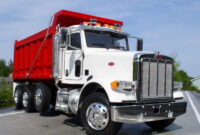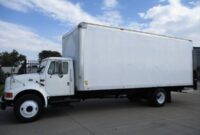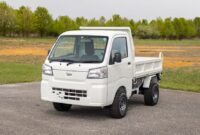Light Duty Flatbed Tow Trucks For Sale: Your Comprehensive Guide to a Smart Investment pickup.truckstrend.com
In the dynamic world of vehicle recovery and transport, the light duty flatbed tow truck stands as a pillar of versatility, safety, and efficiency. Far more than just a vehicle for hire, it’s a critical asset for towing companies, auto repair shops, dealerships, and even private collectors. For anyone looking to enter the towing industry or upgrade their existing fleet, understanding the nuances of light duty flatbed tow trucks for sale is paramount. This comprehensive guide will navigate you through everything you need to know, from defining these essential machines to making a savvy purchase.
What Defines a Light Duty Flatbed Tow Truck?
Light Duty Flatbed Tow Trucks For Sale: Your Comprehensive Guide to a Smart Investment
A light duty flatbed tow truck, often simply called a "rollback" or "slide truck," is characterized by its specialized hydraulic bed that can be tilted and slid backward, forming a ramp onto which a disabled or damaged vehicle can be driven or winched. Unlike traditional "hook-and-chain" or "wheel-lift" tow trucks that lift only two wheels of the towed vehicle, a flatbed transports the entire vehicle on its platform, with all four wheels off the ground.
These trucks are typically built on commercial truck chassis from manufacturers like Ford (F-450, F-550), Ram (4500, 5500), or Chevrolet (4500HD, 5500HD). They fall into the "light duty" category based on their Gross Vehicle Weight Rating (GVWR), which generally ranges from 14,001 lbs to 26,000 lbs, allowing them to tow most passenger cars, light trucks, motorcycles, and small equipment. The flatbed body itself is engineered for strength and stability, featuring a powerful winch at the front for pulling vehicles onto the deck, and various tie-down points to secure the load. Many also include a "wheel lift" or "under-reach" attachment at the rear, allowing them to tow a second vehicle or maneuver vehicles in tight spaces.
Why Choose a Light Duty Flatbed? Key Benefits
The widespread adoption of flatbed tow trucks isn’t accidental; it’s driven by a host of compelling advantages that make them the preferred choice for many towing scenarios:
-
Unparalleled Versatility: Light duty flatbeds can handle an incredibly diverse range of vehicles. From compact cars and luxury sedans to SUVs, pickup trucks, motorcycles, ATVs, and even small construction equipment, the flatbed’s design accommodates almost anything that fits on its deck. This makes them ideal for various jobs, including accident recovery, breakdown assistance, vehicle transport, and even moving specialized equipment.
-
Superior Vehicle Safety: This is perhaps the most significant advantage. When a vehicle is loaded onto a flatbed, all four of its wheels are off the ground, eliminating any stress on the drivetrain, suspension, or steering components. This is crucial for all-wheel-drive (AWD) vehicles, classic cars, low-profile sports cars, and luxury vehicles that can suffer damage from conventional towing methods. It also prevents unwanted mileage accumulation on the towed vehicle.
-
Reduced Risk of Damage: By lifting the entire vehicle, flatbeds virtually eliminate the risk of scrapes, dents, or scratches that can occur when vehicles are dragged or partially lifted. This reduces liability for the towing operator and ensures customer satisfaction, which is vital for business reputation.

-
Operator Efficiency and Safety: Modern flatbeds feature hydraulic controls that make loading and unloading vehicles relatively straightforward and safe. Operators can often load a vehicle faster and with less physical strain compared to struggling with chains or dollies, especially in adverse weather conditions or on busy roads.

Market Demand and Insurance Preference: Many insurance companies and vehicle owners specifically request flatbed towing due to its inherent safety. Investing in a flatbed positions your business to meet this demand, potentially leading to more call-outs and a competitive edge.

Key Considerations When Buying a Light Duty Flatbed Tow Truck
Purchasing a light duty flatbed tow truck is a significant investment that requires careful consideration of various factors to ensure you acquire the right asset for your needs.
New vs. Used: The Perennial Debate
- New Trucks: Offer the latest technology, full manufacturer warranties, greater reliability, and often better financing options. However, they come with a higher upfront cost and immediate depreciation.
- Used Trucks: Provide a lower entry price point, making them attractive for startups or those with tighter budgets. The challenge lies in assessing their condition, maintenance history, and potential for unexpected repairs. A thorough pre-purchase inspection is critical.
Chassis and Engine
The foundation of your tow truck is the chassis. Reputable brands like Ford, Ram, and Chevrolet are common choices due to their robust construction and widespread service networks.
- Engine Type: Consider gas vs. diesel. Diesel engines typically offer more torque for heavy loads, better fuel efficiency under load, and a longer lifespan, but come with higher purchase and maintenance costs. Gas engines are cheaper to buy and maintain but may lack the raw power for continuous heavy-duty work.
- Transmission: An automatic transmission is standard and generally preferred for ease of operation. Ensure it’s heavy-duty and well-maintained.
Flatbed Body and Deck Material
- Steel vs. Aluminum: Steel decks are durable, strong, and generally less expensive, but they are heavier, which reduces your truck’s payload capacity and can impact fuel efficiency. Aluminum decks are significantly lighter, allowing for greater payload and better fuel economy, but they are more expensive and can be more susceptible to certain types of damage.
- Deck Length and Width: Choose a size appropriate for the vehicles you plan to tow. Standard lengths range from 19 to 22 feet.
- Load Capacity: Ensure the flatbed’s rated capacity aligns with the weight of vehicles you intend to transport regularly.
Winch and Recovery System
- Winch Capacity: The winch is critical for pulling vehicles onto the bed. It should have a pulling capacity at least equal to, and ideally greater than, the heaviest vehicle you expect to tow.
- Cable Type: Steel cable is standard and durable, but synthetic rope is lighter, stronger, and safer (less recoil if it breaks).
- Remote Control: A wireless remote for the winch and bed functions significantly enhances operator safety and efficiency.
Wheel Lift (Optional but Highly Recommended)
A rear wheel lift allows you to tow a second vehicle, perform repossessions, or easily maneuver vehicles in tight spots. If your business model includes these services, a truck equipped with a robust wheel lift is a definite plus.
Storage and Toolboxes
Ample, secure storage for chains, straps, dollies, recovery equipment, and tools is essential for any tow operator. Look for integrated toolboxes and chain racks.
Lighting and Safety Features
LED lighting for visibility, work lights for night operations, strobe lights for safety on busy roads, and backup cameras are crucial for safe and efficient operation.
GVWR and Licensing Requirements
Understand the truck’s GVWR. Depending on the rating and your state’s regulations, you may need a Commercial Driver’s License (CDL) or specific endorsements. Always check local and federal Department of Transportation (DOT) regulations.
Budget and Financing
Beyond the purchase price, factor in insurance, fuel, maintenance, tires, and potential financing costs. Explore different financing options from banks, credit unions, or specialized equipment lenders.
Where to Find Light Duty Flatbed Tow Trucks For Sale
The market for tow trucks is diverse, offering several avenues to find the right vehicle:
- Authorized Dealerships: New tow truck sales often happen through authorized dealers of specific chassis manufacturers (e.g., Ford, Ram, Chevy) who then outfit them with specialized flatbed bodies from companies like Miller Industries (Century, Vulcan, Holmes), Jerr-Dan, or Landoll. These dealers offer warranties, financing, and service.
- Specialized Used Truck Dealerships: Many dealerships focus solely on selling used commercial trucks, including a wide range of tow trucks. They often have a larger inventory of different makes and models.
- Online Marketplaces: Websites like TruckPaper.com, CommercialTruckTrader.com, and even general marketplaces like eBay Motors or Facebook Marketplace can list numerous trucks for sale, both from dealers and private sellers. Exercise caution and always verify sellers.
- Auctions: Government surplus auctions, police auctions, and commercial equipment auctions can be sources of good deals, but they often come with a "buyer beware" caveat. Inspections are crucial, as vehicles are typically sold "as-is."
- Direct from Owners: Sometimes, smaller towing companies or independent operators sell their trucks directly. This can offer negotiation flexibility but requires thorough due diligence.
- Trade Shows: Attending industry trade shows allows you to see the latest models, compare features, and network with manufacturers and dealers.
Tips for Inspecting and Purchasing
Once you’ve identified a potential truck, a meticulous inspection process is vital, especially for used vehicles:
- Pre-Purchase Inspection (PPI): Always invest in a professional third-party mechanic’s inspection. They can identify hidden issues with the engine, transmission, frame, and suspension.
- Hydraulic System Check: Test the flatbed’s tilt, slide, and winch functions repeatedly. Look for leaks, slow operation, or unusual noises. Inspect hydraulic lines and cylinders.
- Winch Operation: Ensure the winch spools correctly, has sufficient power, and the remote control (if present) functions properly. Check the condition of the winch cable/rope.
- Electrical System: Verify all lights (headlights, tail lights, warning lights, work lights), gauges, and electrical components are working.
- Tires and Brakes: Check tire tread depth and condition. Test the brakes thoroughly – look for pulling, grinding, or soft pedals.
- Frame and Body: Inspect the frame for any signs of cracks, rust, or previous repairs. Check the flatbed deck for excessive wear, damage, or soft spots.
- Test Drive: Drive the truck at various speeds. Listen for unusual engine or transmission noises, check steering response, and ensure smooth gear changes.
- Review Maintenance Records: For used trucks, a detailed service history can provide invaluable insight into how well the truck was maintained.
- Verify Documentation: Ensure the title is clear, there are no outstanding liens, and all necessary registration documents are available.
Practical Advice and Actionable Insights
- Define Your Needs First: Before you even start looking, clearly define the types of vehicles you’ll be towing, your typical service area, and your budget. This will narrow down your options significantly.
- Factor in Operating Costs: Remember that the purchase price is just one component. Fuel, insurance, routine maintenance, and unexpected repairs will be ongoing costs.
- Consider Resale Value: Reputable brands and well-maintained trucks tend to hold their value better.
- Invest in Training: Proper training for operators on safe loading, securing, and operating procedures is non-negotiable for safety and efficiency.
- Don’t Skimp on Safety: Always prioritize trucks with robust safety features, reliable braking systems, and clear visibility. Your operators’ lives and the safety of the towed vehicles depend on it.
Concluding Summary
A light duty flatbed tow truck is a cornerstone asset for any professional involved in vehicle recovery and transport. Its unparalleled versatility, superior safety for towed vehicles, and operational efficiency make it a wise and often necessary investment. By carefully considering factors such as new vs. used, chassis and engine specifications, bed material, and essential features like the winch and wheel lift, buyers can make an informed decision. Sourcing from reputable dealers and conducting thorough inspections are key steps to securing a reliable and profitable asset. A well-chosen light duty flatbed is not just a truck; it’s the foundation for a successful, safe, and highly demanded service in the automotive world.
Price Table: Estimated Costs for Light Duty Flatbed Tow Trucks For Sale
Please note: These are estimated price ranges and can vary significantly based on the truck’s condition, mileage, specific features, chassis brand, flatbed manufacturer, region, and market demand. Always get specific quotes.
| Category | Chassis Type (Examples) | Capacity Range (GVWR) | Key Features (Typical) | Estimated Price Range (USD) |
|---|---|---|---|---|
| Used (Entry-Level) | Ford F-450/F-550, Ram 4500/5500 (Older Models) | 14,000 – 19,500 lbs | Basic steel bed, standard winch, higher mileage (150k+ miles), potential wear and tear. | $25,000 – $55,000 |
| Used (Mid-Range) | Ford F-550, Ram 5500, Chevy 5500HD (Mid-Age) | 19,500 – 26,000 lbs | Steel or aluminum bed, hydraulic wheel lift, remote winch, average mileage (75k-150k miles), good condition. | $55,000 – $90,000 |
| Used (Premium) | Ford F-600, Ram 6500, Freightliner M2 (Newer, Low Mileage) | 26,000 lbs (often with air ride) | Aluminum bed, integrated wheel lift, advanced controls, low mileage (<75k miles), excellent condition. | $90,000 – $130,000+ |
| New (Basic) | Ford F-450, Ram 4500 | 14,000 – 16,000 lbs | Steel bed, standard winch, no wheel lift or basic wheel lift, entry-level options. | $100,000 – $130,000 |
| New (Standard) | Ford F-550, Ram 5500, Chevy 5500HD | 19,500 – 26,000 lbs | Steel or aluminum bed, hydraulic wheel lift, remote control, LED lighting, various options. | $130,000 – $180,000 |
| New (Premium/Custom) | Ford F-600, Ram 6500, Freightliner M2 | 26,000 lbs (heavy duty chassis) | Aluminum bed, advanced hydraulics, high-capacity winch, fully loaded with safety and convenience features, custom paint/graphics. | $180,000 – $250,000+ |
Frequently Asked Questions (FAQ)
Q1: What’s the average lifespan of a light duty flatbed tow truck?
A1: With proper maintenance, the chassis of a light duty flatbed truck can last 300,000 to 500,000 miles or more. The flatbed body itself, being largely hydraulic and steel/aluminum, can often outlast multiple chassis if well-maintained, sometimes 15-20 years or longer.
Q2: Do I need a special license (CDL) to operate a light duty flatbed?
A2: It depends on the truck’s Gross Vehicle Weight Rating (GVWR) and your state’s regulations. Most light duty flatbeds (up to 26,000 lbs GVWR) can be operated with a standard Class D (non-commercial) driver’s license in many states, as long as they are not towing a trailer that puts the Gross Combination Weight Rating (GCWR) over 26,000 lbs. However, some states may require a specific endorsement or a Class B CDL for vehicles over a certain weight. Always check your local Department of Motor Vehicles (DMV) or DOT regulations.
Q3: What’s the main difference between a steel and an aluminum flatbed deck?
A3: The primary difference is weight. Aluminum decks are significantly lighter, which allows for a greater payload capacity and can improve fuel efficiency. However, aluminum beds are generally more expensive and can be more susceptible to certain types of damage (e.g., concentrated impacts). Steel decks are heavier and more affordable but are very durable and resistant to impact damage.
Q4: How much does insurance typically cost for a light duty flatbed tow truck?
A4: Insurance costs vary widely based on several factors: the truck’s value, your location, your driving record, the type of operations (e.g., roadside assistance, accident recovery, repossessions), and the coverage limits you choose. Expect to pay anywhere from $5,000 to $15,000+ annually for commercial tow truck insurance. It’s crucial to get multiple quotes from insurance providers specializing in commercial auto and towing operations.
Q5: What kind of maintenance is typically required for a flatbed tow truck?
A5: Regular maintenance is critical. This includes routine oil changes, fluid checks (transmission, differential, hydraulic), tire rotations and inspections, brake checks, and greasing of all moving parts (e.g., pivot points on the bed, winch components). The hydraulic system (pumps, hoses, cylinders) requires particular attention for leaks and proper functioning. Annual DOT inspections are also mandatory for commercial vehicles.


